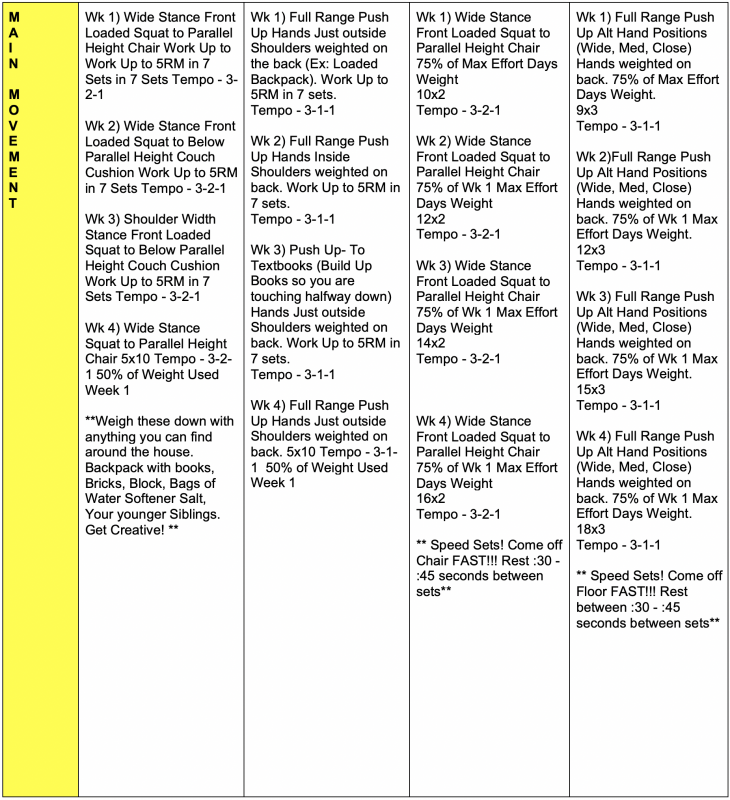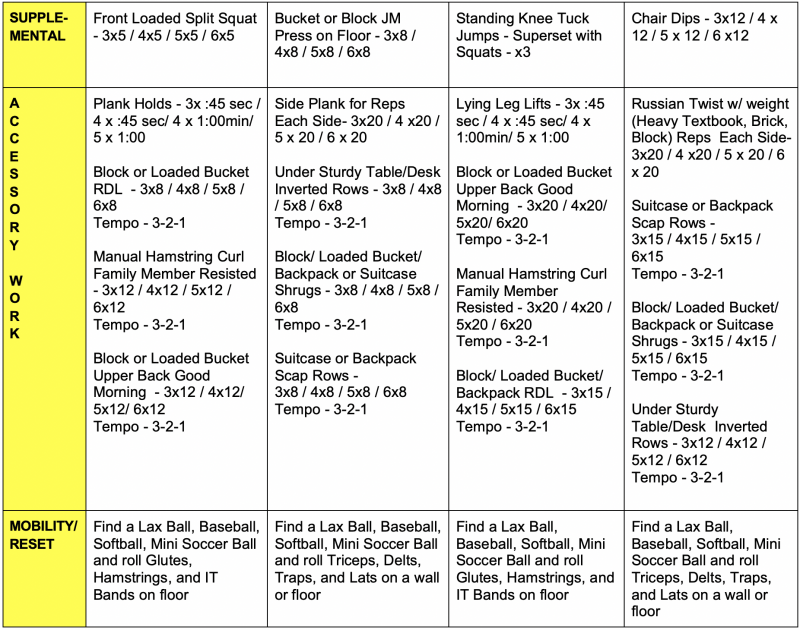
This mandated quarantine has left us all in a bind when it comes to training and having access to equipment and facilities. Some of us will have access to everything we need or at least the bare essentials (shout out to all my fellow home gym owners!). We've seen many people attempting to build home gyms now and flooding the market for our exercise equipment suppliers and vendors. Many others will have no other choice but to try and piece together beneficial training with next to nothing but their body and household items because of availability or financial constraints. We've all seen the random exercises thrown together across the internet with no semblance of programing or overall goal. I get it, put out content, so you're doing something rather than nothing at all. However, many of these workouts could be used at best for GPP (General Physical Preparedness). What about actual programming and loading that will continue to benefit the long-term strength development of the athlete?
From the way the current state of affairs is looking, we're stuck in the situation for a few months. So, we need something that takes this into account for those athletes lacking equipment training facilities. The overall goal of this article is to lay out a four-week conjugate training cycle that considers this lack of equipment and takes into account the wave loading of volume over four weeks. Readers can modify movements based upon what's available. The target audience for this sort of training plan is a middle/high school athlete or novice lifters.
RECENT: Lee Zimmerman's Home Gym Stays Open!
The adjective conjugate means "to couple together," so within this training style, "several abilities are coupled together throughout the training" (Tate, "Periodization Bible Part 2", 2010). This training style incorporates the three main methods of training: the maximal effort method, the dynamic effort method, and the repetition effort method. For a more in-depth explanation of these methods and how to execute them effectively, please refer to the cited "Periodization Bible Part II" article by Dave Tate. In short, the maximal effort method involves straining at weights above 90% of a 1RM to increase the mother of all strengths, maximal strength. The dynamic effort method involves using submaximal weights and moving them as fast as possible. The repetition effort method is more of your traditional or bodybuilding style of training, where the main goal is hypertrophy or an increase in lean muscle mass. One of the biggest benefits of conjugate training is the way it variates movements to prevent accommodation. So, we have many options at our disposal to change up the training plan and keep things exciting and fresh.
So how can we build a training template to train these three methods with minimal equipment? For this model, we will layout the standard "Westside" training days of Monday, Wednesday, Friday, Sunday in our week. Our training days will be structured as follows: Monday- max lower, Wednesday- max upper, Friday- dynamic lower, and Sunday-dynamic upper. But these days can be manipulated however you like as long as you allow for 72 hours of rest between intense training sessions of the same body area. Each training day will be structured as follows:
Base Template
Warm-Up: We at Iron Dread SC like to use a potentiated warm-up in the style of Matt Wenning's "Wenning Warm-Ups." The way we do this consists of three exercises, done for usually 3-4 sets of 25 reps in a cluster set fashion with 20 seconds of rest in between sets. These movements will potentiate or turn on the main muscles we are going to train that day. The weights are light enough to complete all the reps while feeling the work in the intended muscle group.
Main Movement: Max Effort or Dynamic Effort Work: A more detailed breakdown to follow. For this program, we will use a lot of 3- and 5-rep max work since the equipment will be minimal.
Supplemental Movement: The movement after max effort or dynamic work that helps to build on the main weak point of that day.
Accessory Work: This is where we incorporate the repetition effort method to build weak points. This will be 3-4 movements and can be done in a circuit or a more traditional style.
Mobility/Reset Work: This is where we will have some sort of mobility work to help aid in recovery and keep tissues and joints mobile.
Now, let us move into an example 4-week training cycle. I will provide examples for no equipment except items that the majority of people may have around the house. If you are looking to invest in your training, the best bang for your buck investment is bands. You can add bands to any of these movements and instantly double the number of exercise variations at your disposal. If you have access to barbells, heavy dumbbells, a power rack, or more, you can simply use barbell or dumbbell movements in this template to structure your training. I encourage you to seek out more information on how to properly use these items in your training and fundamental movement technique, which is not covered here. Also, if you choose to use any of these training suggestions, you do so at your discretion and risk.
Some basics on how to read this program:
- RM: Rep Max
- Set Tempos: Down - Pause - Up (Eccentric-Isometric-Concentric)
- Sets and Reps: Number of Sets x Number of Reps
- Week Separation: Each training week is divided by a "/"mark. Anything written once will stay the same from week to week unless otherwise marked.
Extra Workouts in Between Training Days
A staple of conjugate training is adding extra work in between training days to aid in recovery and help build weak points. Some suggestions are:
Tire Drags: Grab an old tire you may have lying in the garage and a ratchet strap. Hook the strap around the tire and then run the smooth part of the strap around your waist. Then walk forward upright striking heel first across a grassy area dragging the tire behind you. If its light walks for time, start with 10 minutes, then increase the next time to 15 minutes, then 20 minutes the time after that. The 4th time you drag the tire, change something about it — like add weight to it with a block, bucket, or little brother, but don't make it too heavy that you can't hold form for the full amount of time. If the tire is heavy, mark off a distance of about 60yds and drag the tire for ten trips holding good form. The next time, drag the tire 12 trips, the time after 14. The 4th time you drag the tire, change weight or distance and go back to 10 trips.
Extra Accessory Work: Add in extra accessory movements. They can be the same ones listed above or something new. Make sure these are small muscle group movements and not big compound movements. Remember, extra work should help build weak points and help us recover, not make us so sore we can't complete the next training session.
Walking/Cardiovascular Exercise: Throughout the day, add in some 10-15-minute brisk walks. Doing this after multiple times a day can break up the time you're stuck in the house sitting down. These can be around your neighborhood, on a trail, or on a treadmill. If you have a bike or some other piece of cardio equipment, use it! Put these in multiple times per day. These things will help promote blood flow for recovery and, of course, aid in the development of your cardiovascular fitness. Doing multiple shorter bouts has been suggested to be more beneficial than one longer session all at once. If you are an endurance athlete, add your runs in a wave-loaded fashion.
In closing, I hope this article inspires you to get creative with your training over this mandated quarantine. If you have equipment, add it in and increase your variations. Finding ways to train will help you grow through this quarantine instead of getting weaker and wasting away on the couch. Best of luck, and I hope we get back to normal life soon!
References
- Harvey, Nate. ConjugateU. Nate Harvey, 2017, Elitefts.com/conjugateU, www.elitefts.com/conjugate-u-by-nate-harvey.html.
- Tate, Dave. (2010, June 27). Retrieved from https://www.elitefts.com/education/training/powerlifting/efs-classic-the-periodization-bible/
- Wenning, Matt. "Wenning Warm-Ups ." 11 Feb. 2019, www.youtube.com/watch?v=o61dLV9ccXA. Accessed 26 Mar. 2020.
Header image credit: Ekaterina Pereverzeva © 123rf.com
Chris Whittaker, CSCS, is the strength coach and health teacher at Dexter High School in Dexter, Michigan. He has worked with athletes of various age levels across New York, North Carolina, and now Michigan, mainly focusing on middle and high school athletics. Three years ago, Whittaker started the Iron Dread Strength Program at Dexter High that serves student-athletes grades fifth through alumni. This program is centered around a conjugate training model and has made exponential growth since its inception. He also started a powerlifting program for grades 8-12 and currently competes in small regional USAPL meets. Whittaker earned his B.S. in Physical Education from The New York State College in 2010, and M.S. from Emporia State University in Health, Physical Education, and Recreation in 2013.













